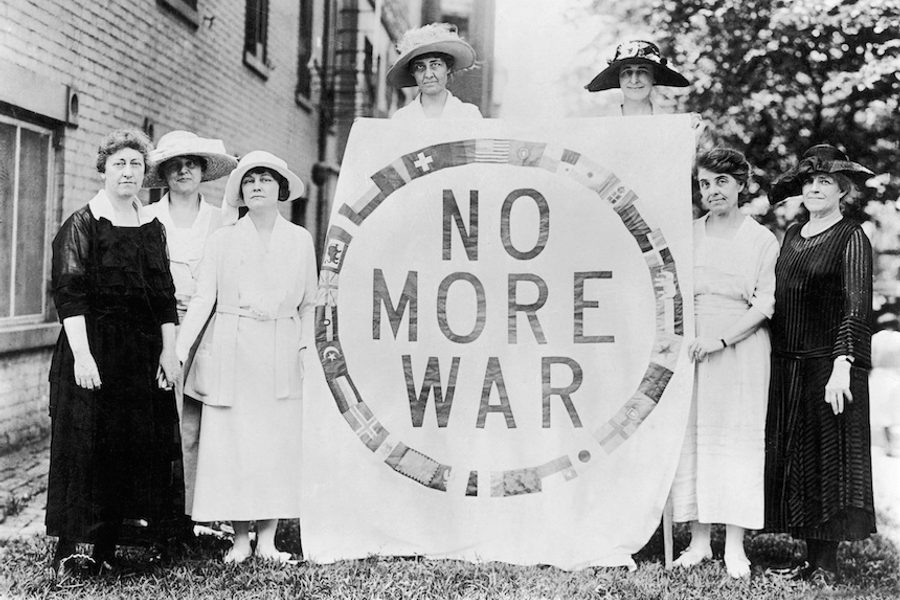What We Can Learn From the Pacifist Movement Against World War I
Although they failed to keep us out of the war, they organized effectively in conditions frighteningly similar to our own.
Theo Anderson

Everything might have been different if the United States had heeded the pacifist movement and stayed out of World War I. That’s the suggestion made by Michael Kazin, a professor of history at Georgetown University and editor of Dissent, in War Against War: The American Fight for Peace, 1914-1918, a new book that traces the movement’s ultimately doomed efforts to keep the U.S. from entering the war, and to resist it once that effort failed.
The United States’ decision to take up arms on the side of the Allies in early 1917, Kazin writes, was “a turning point in world history.” It set in motion the creation of the surveillance state and a federal bureaucracy tasked with crushing dissent and disseminating government-approved versions of truth. And it may have paved the way for the fascist regimes that rose to power in Europe in the 1920s and 1930s, Kazin writes, by foreclosing “the possibility of a negotiated peace among belligerents exhausted by nearly three years of fighting.” Instead, the Allies imposed their will on the broken Germans, sowing the seeds of resentment that Hitler would soon exploit.
Much of the ground Kazin covers in War Against War feels frighteningly familiar today. He describes the glimmers of fascism on the horizon; the post-truth propaganda, disseminated by a servile media; and the liberal president, Woodrow Wilson, who inspires people with his words while disappointing and dividing the Left with his actions. Most importantly, he takes us back to a crossroads in history, when the choices made would shape the nation’s future in decisive ways. It doesn’t take much imagination to hear, in the gravity of the threats we now face, echoes of 1917.
The pacifists failed in their near-term goal, certainly, but that isn’t the whole story. Kazin reminds us that the meaning of the pacifist movement in World War I is still manifesting and evolving. “A grand cause that fails may, sometimes, matter as much as one that succeeds,” Kazin writes. “That failure can mark, with a bright line, a moment when a people and their government might have avoided making a decision that fundamentally changed their society.”
The eventual failure of the pacifist movement to keep the nation out of war obscures the fact that it did succeed, from 1914 to early 1917, in delaying U.S. involvement by building a broad coalition that was firmly rooted both in electoral politics and in social movements for equality, especially the suffragist movement.
One of the most notable politicians in the fight, Robert La Follette, a Republican senator from Wisconsin, failed to persuade his colleagues but used his platform to boldly critique the buildup to the war, and then war itself, as a profiteering mission in which the only parties sure to benefit were industrialists.
The tension between that critique of war and Wilson’s high-minded rationale for entering it imbues the story of American involvement in World War I with a tragic hue and an enduring fascination. As escalating nationalism made the declaration of war all but inevitable, Wilson positioned himself—and the nation—as the redemptive forces that would bring about a just peace and prepare the soil in which democracy could take root across Europe.
That was a deeply appealing message for progressives. War Against War’s great strength is in laying out the pitfalls and fractures the pacifist movement confronted—seduction by Wilson’s idealism, along with the pull to take part in other, equally urgent causes—while showing how it created a strong enough base, and a powerful enough critique, to push back against U.S. entry for three years.
A small example of its resourcefulness is the exhibit that gives the book its name, “War Against War,” which the American Union Against Militarism staged in 1916. The exhibit, Kazin notes, “featured savagely witty cartoons, captivating speakers, and a number of imaginative displays meant to dramatize the foolishness of preparing for war in order to preserve peace.” In Brooklyn, where it opened in the spring, the exhibit drew up to 10,000 visitors per day, and it stirred up enough anger that a grand jury weighed whether to indict the creators. A jury member said that the exhibit’s “purpose [was] questionable, if not treasonable.” That effort failed, and the exhibit moved on to 10 more cities over the summer.
Yet less than a year later, the nation would be at war. Such rapid reversals of fortune are a recurring theme in War Against War. Wilson got the war he wanted but was soon humiliated by the European powers as well as the U.S. Congress, which in 1920 declined to join the League of Nations he had pushed for. Meanwhile, the pacifists were soon vindicated by public opinion, which coalesced around their critique of the war as an adventure in profiteering.
The pacifists lost their war against war, but “their legacy is not simply one of failure,” Kazin writes. “By warning, credibly, about the consequences of American intervention, they were transformed from ‘traitors’ into something akin to prophets.” As Donald Trump prepares to hand over key areas of U.S. policy to a clique of generals known for their rabid militarism, it’s worth studying both the failures of the pacifists and the alternative vision they successfully kept alive. We’ll never know what a 20th century would have looked like without an imperialist United States. But as we face a new crossroads, we can imagine what could have been, and what the 21st century might yet be.









